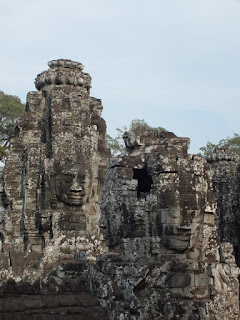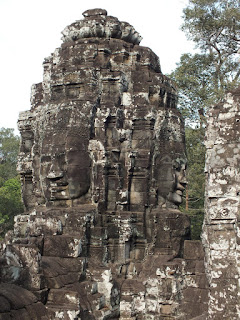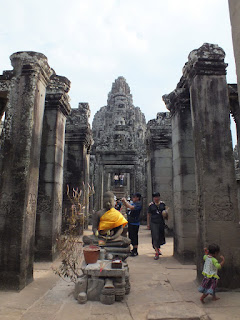This post is part of a series on our recent trip to see the temples of Angkor in Siem Reap, Cambodia. You can see our first post here.
After spending the morning touring the temples of the ancient Khmer city of Hariharalaya, referred to by the modern name of Rolous - and after a lazy lunch and an early afternoon siesta to escape the brutal heat - Nana and I struck out for Angkor Thom, the holy city at the heart of golden-age Angkor.
Angkor Thom
Angkor Thom ("Great City") was built at the end of the 12th century by
Jayavarman II. Jayavarman II, as you may recall, was the king who tried to add his own Buddhist faith to the Hindu state religion. The last great king of the Khmer Empire. Jayavarman II and presided over a golden age that included, among other accomplishments, a massive building project responsible for a staggering number of the most important surviving temples of Angkor.
The architecture of Jayavarman II's reign is characterized by a blend of Buddhist and Hindu motifs. This blend is most memorable in the "face towers" that mark the entrances to every major structure he built.
However, the south gate of Angkor Thom is perhaps best known for a major work of Hindu monumental art: a causeway flanked by an elaborate
naga balustrade depicting the Hindu story of the
churning of the ocean of milk (generally believed to represent the Milky Way).
To make a long story short, in the early days of the present universe the demigods and demons learned that they had to churn this cosmic ocean of milk in order to obtain the nectar of immortality. However, they were unsuccessful so long as they refused to cooperate. Vishnu eventually got the demons to take the head of a giant naga, and the demigods to take the head. Using a mythical mountain as a pivot, with some help from
Kurma (Vishnu in the form of a giant turtle), they succeeded, spawning a bunch of other cool stuff, like and dancing
apsaras and
Lakshmi, the wife of Vishnu. (Caution: this is not the last you will hear of this tale.)
Each entrance to Angkor Thom includes a balustrade depicting the demons and demigods pulling on he naga, with the south entrance - being both closer to Siem Reap and pretty well preserved - by far the most popular spot. Here, the right side depicts demons, and the left demigods.
 |
| Demon: bulging eyes, curly hair. |
 |
| Demigod: placid face, pointy hair. |
Cool fact: no two demons or demigods look alike. This one helper is particularly unique:
Unfortunately, many of the heads are missing - stolen, most likely, and sold on the black market to collectors. These days, there's an ongoing project to restore some of the missing heads, sometimes by locating them in museums overseas, and sometimes by replacing them with the work of local stone carvers.
At the end of the balustrade stands a face tower, simultaneously representing (did you study?) Brahma, the Four Noble Truths of Buddhism, and Jayavarman II.
Brahma-Buddha-Jayavarman is flanked by images of
Airavata, the three-headed elephant ridden by
Indra, who figures in both Hindu and Buddhist mythology.
The south gate face tower is especially nice because you can walk up the sloped ramparts behind the city wall and get pretty close to the tower itself.
Today, the land inside the city walls is mostly forest, dotted with temples. In the reign of King Jayavarman II, however, the land would have been filled with a bustling wooden city that was one of the largest in the world at the time.
The Bayon
The Bayon was Jayavarman II's state temple, set at the heart of Angkor Thom. Built around 1200 AD, the Bayon is unique among Angkor state temples. Most state temples were temple mountains built to impress, like
Bakong in Hariharalaya, or of course
Angkor Wat. The Bayon is a much more intimate setting, a tangled jungle of galleries and face towers with short sight-lines, surprising corners, and a pair of Brahma-Buddha-Jayavarman's eyes watching over you wherever you turn.
Furthermore, the Bayon is the only surviving Angkor temple dedicated to Buddha (most were dedicated to Shiva, with a handful dedicated to Vishnu).
We spent the first part of our visit poring over the galleries, whose walls are covered in a seven-foot bas relief.
These carvings are unique in that, alongside the usual historical and mythological fare, they also illustrate scenes from everyday life in the Khmer Empire. As a result, they're one of only two remaining sources on what life was like for the regular folk in ancient Angkor. (The other is an account by a Chinese envoy named
Zhou Daguan, who visited Angkor Thom in 1296-1297.)
 |
| A procession of Chinese soldiers, identifiable by their eyes and beards. |
 |
| In this particular conflict, the Chinese were allied with the Khmer against the Cham, a kingdom in what would now be Vietnam with ethnic ties to Taiwanese aborigines and Pacific Islanders. |
 |
| Khmer soldiers, identified by their long earlobes and the crossed ropes, which were sacred and therefore supposed to protect the wearer from harm. |
 |
| A family with an oxcart full of provisions follows the conquering army. |
 |
| Butchering a pig. |
 |
| Blowing on the fire to get the rice going. |
 |
| According to our guide, this turtle has just bitten the soldier in the butt. |
 |
| Hunting in the forest. The apparently flying fish are from the "panel" above, which depicts a battle on Lake Tonle Sap. |
 |
| Childbirth. |
 |
| A theraputic massage. |
 |
| A man being eaten by a lion. |
 |
| Cockfighting, with Chinese merchants on the right and Khmer merchants on the left. Again, the giant airborne fish is from another "panel" of the illustration. |
 |
| Khmer soldiers training for battle. |
 |
| A Khmer soldier killing a Cham soldier. The Cham soldiers are identifiable by their lotus-flower headdresses. |
 |
| Cooking for the troops. |
 |
| A fallen soldier being eaten by a crocodile. |
In all honesty, I may have become mildly obsessed with these bas reliefs. Like so many of the carvings at Angkor, the Bayon reliefs are just full of life and humor - a quality that seems to have been passed down to the Khmer people through the generations. Every minute spent staring at these reliefs shows you something new and, half the time, funny.
After leaving the galleries, we began ascending the modest temple mountain of the Bayon, stopping for frequent photos of the countless faces peering down at us.
I think in this case, it's best to let the pictures speak for themselves.
 |
| Sometimes, it's like Where's Waldo. The face is always there - if you haven't found it, it just means you're not looking hard enough. |
 |
| Nana got a little frisky with this one. |
 |
| As you can tell, each of the faces is slightly different, and those slight differences add up to a major change in expression. This is by far the happiest of the faces - check out that developing smirk! |
Fun side note: as we were leaving the Bayon, we stumbled on two heart-warming hints of modern activity on the site. (I say this to distinguish them from the hordes of shouting tourists, who were considerably less heart-warming.)
 |
| There cannot have been many Koreans left in Korea. |
First, we came across a Japanese-led team working on restoring one of the lower levels of the temple.
Japan is among several nations heavily involved in conservation and restoration at Angkor. At the entrance to nearly every temple, you can see a sign describing the conservation team and its efforts. I hope to talk about this more in a later post.
Second, we see a modern Buddhist shrine in bright saffron. Had I been less shy about asking for their permission, I would have gotten a shot of the monks stepping barefoot through the ruins.
That's right - the Bayon, like many Angkor sites, is a modern place of worship for Cambodia's Buddhist majority. Kind of ironic, in a way: despite the efforts of Jayavarman II's successors to erase his Buddhist influence on the empire, it was Hinduism that eventually died out in Cambodia, with even the most Hindu of Angkor shrines being used as Buddhist temples to this day.
 |
| Another empty niche, another defaced Buddha. |
Baphuon
After the Bayon, we made a couple quick stops at other Angkor Thom sites. First up was
Baphuon, sometimes called the world's greatest jigsaw puzzle.
This temple-mountain, which pre-dates the rest of Angkor Thom by more than a century, was in almost complete disrepair as recently as fifteen years ago, and was only partly opened to the public in 2010. Baphuon has been the focus of a massive reconstruction effort led by the French, which concluded (for now) in April 2011.
You can see evidence of the restoration work everywhere. For instance, the grounds around Baphuon are covered with sorted and numbered sandstone blocks from the original temple, some of which have been replaced with careful replicas, others of which might, sometime in the future, find their way back into the temple.
These fields of stone also provide a physical record of the original temple - in theory, it would be possible for someone with a knowledge of the numbering system to recreate a picture of where each stone was found in the original ruin.
The current structure is a kind of historical jungle gym. Thankfully, by the time we started climbing, a cloud bank had rolled in, giving us a
little respite from the heat.
 |
| For reference, that structure is about 1.5 storeys off the forest floor. |
 |
| Steep! |
 |
| A gallery of restored columns, about 3-4 storeys up. |
 |
| Looking down on the causeway, to the east. |
 |
| You can see the difference between color in the restored and original stones. |
 |
| The central tower has not been restored, though oddly enough the doorposts have. |
 |
| A view from Baphuon to Phimenakas, the next temple over. |
One side of Baphuon has been left untouched by the restoration team, as it features a later "reclining Buddha" image carved into the original wall.
 |
| It's a bit easier to spot after you've looked at the diagram. |
Phimeanakas
Phimeanakas is what passes for a minor temple in Angkor Thom: you know, only about four storeys high, and older than everything else in Angkor Thom by a couple measly centuries. It was originally the state temple of
Suryavarman I. It later served as the palace temple for a series of Khmer kings.
We climbed it, of course. Because we're masochists.
 |
| A fallen stone roof on the penultimate level. |
The Royal Square
East of Phimeanakas, at the edge of what used to be the royal palace, are two huge terraces overlooking an empty field. These two terraces, the
Terrace of the Elephants and the
Terrace of the Leper King, along with the adjoining field, are referred to collectively as the Royal Square of Angkor Thom.
It's assumed that the square was used for public addresses and other ceremonies, possibly including royal cremations and the launching of military campaigns.
 |
| Atop the Terrace of the Elephants. |
The Terrace of the Elephants is so called because it's, well, covered in elephants, and especially in images of Airavata.
The Terrace of the Leper King is named after a later statue of
Yama, the Hindu god of death, who apparently looked a bit leprous after centuries in the jungle.
The base of the Terrace of the Leper King features more wonderful relief carvings, including some unfinished patches that both hint at the hard times that befell the late kings of Angkor and give some insight into how the carvings were made.
 |
| Apsaras and concubines. |
 |
| A vivid naga. |
 |
| An unfinished carving of the king, flanked by concubines. |
 |
| A finished image of the king, being fanned by concubines. (Lots of concubines on the Terrace of the Leper King!) |
If you love ancient temples, if you hate ancient temples, or if you're completely ambivalent to ancient temples . . . stay tuned for lots, lots more!
















































































Ha ha ha! You said "blowing."
ReplyDelete